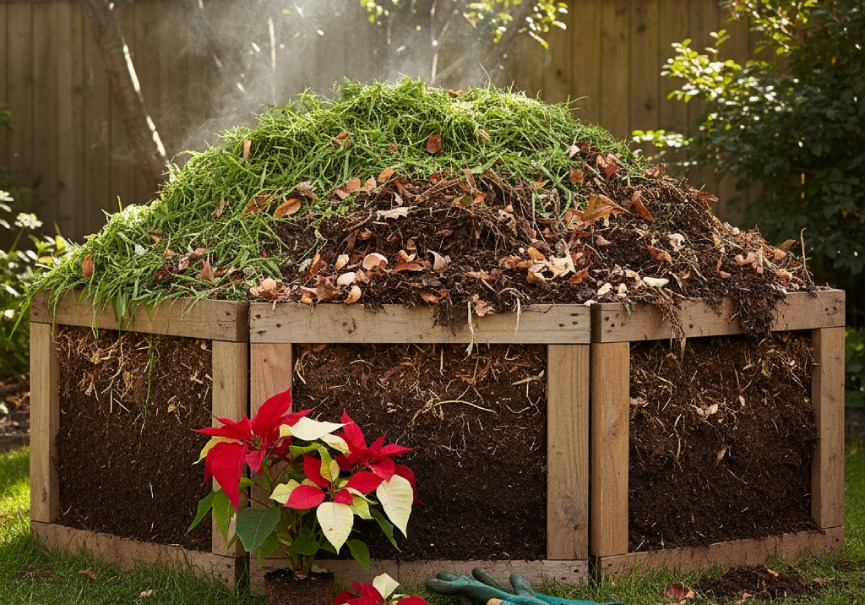Are Japanese Maple Trees Poisonous to Dogs? Understanding the Risk and Ensuring Safety

Introduction:
Are Japanese maple trees poisonous to dogs? We care about our furry friends and want them to be safe. If we love both having gardens and having pets, we might worry about whether the plants around our homes can be dangerous. One plant we might be worried about is the Japanese Maple tree. It’s really pretty with colorful leaves. But when its branches move and leaves make noise, pet owners might wonder: Are Japanese Maple Trees Poisonous to Dogs? In this article, we’re going to look into gardening and pet health to find out if Japanese Maple trees can be bad for dogs. We’ll learn about possible dangers and get advice to make sure both our pets and plants stay healthy and happy together.
Potential Toxic Compounds in Japanese Maple Trees: Unveiling the Facts
Beautiful Japanese Maple Trees: These trees are loved for their pretty leaves and elegant shape. People put them in lots of gardens and yards. But we want to know if they’re safe for our dogs. To find out, we need to see if there are any bad things in the trees that could hurt dogs. Even though Japanese Maples usually aren’t really dangerous, we need to know what’s inside them and what might happen to dogs. In this part, we’ll talk about some things that can be in plants and how they might affect our dogs.
1. Tannins: These are things that come from plants, like in Japanese Maples. A little bit isn’t usually bad, but if a dog eats a lot, it might get a tummy ache.
2. Saponins: These are in lots of plants, including Japanese Maples. If a dog eats too much, it might throw up and have a runny tummy.
3. Cyanogenic Glycosides: Some plants have these, and they can make poison when eaten. Japanese Maples don’t usually have much, but we still need to know.
4. Calcium Oxalate Crystals: Tiny things like sand can be in plants. If a dog chews or eats them, it might feel strange in its mouth. This isn’t usually too bad, but we should still be careful.
Knowing about these things can help us decide if it’s okay to have these trees where our dogs play. It’s good to learn and make sure our dogs stay safe and happy around plants.
Historical Incidents and Cases: Gaining Insights into Japanese Maple Toxicity
When considering the potential risks of Japanese Maple trees for our dogs, examining historical incidents and cases can provide valuable insights. While severe cases of Japanese Maple toxicity in dogs are relatively rare, documented incidents highlight the importance of understanding the possible dangers and being proactive in safeguarding our pets.
1. Stories We’ve Heard: Some dogs have had problems after eating parts of Japanese Maple trees, but it’s not something that happens a lot. These stories show us that we should be responsible and know about possible dangers.
2. How Dogs Can Feel: Dogs that ate parts of these trees had mild to medium problems like tummy aches, throwing up, runny tummy, and drooling. There were very few cases where dogs got really sick.
3. Different Kinds of Trees and Places: Not all Japanese Maple trees are the same. Some might be a bit different in what they have inside. Where the trees grow also matters. But still, the chance of dogs getting sick from these trees is not very high.
4. Dogs Are Different: Just like people react differently to things, dogs do too. What might hurt one dog might not hurt another.
Even though dogs getting sick from Japanese Maple trees isn’t common, we should always watch out and take our dogs to the doctor if they seem sick after being near plants.
Symptoms Of Plant Poisoning In Dogs: Recognizing Potential Signs
To assess the risk of Japanese Maple toxicity for dogs, it’s essential to be aware of the common symptoms associated with plant ingestion. While cases of severe toxicity are rare with Japanese Maples, dogs can still exhibit signs of discomfort if they come into contact with any potentially toxic plant material. By understanding these symptoms, pet owners can quickly identify when their furry friends might be in need of medical attention.
1. Gastrointestinal Distress: One of the most common reactions to ingesting toxic plants is gastrointestinal upset. Dogs may experience vomiting, diarrhea, and excessive drooling as their bodies try to rid themselves of the irritant.
2. Lethargy and Weakness: In some cases, plant toxicity can lead to a decrease in energy levels and overall weakness. Dogs may appear lethargic and unwilling to engage in their usual activities.
3. Loss of Appetite: A sudden loss of interest in food can signal discomfort caused by plant ingestion. A decreased appetite is a common early indicator that something might be amiss.
4. Oral Irritation and Pawing at Mouth: Plants with irritating compounds can cause dogs to paw at their mouths, shake their heads, or exhibit signs of oral discomfort. Redness or swelling around the mouth might also be noticeable.
5. Changes in Urination and Thirst: Some plant toxins can affect a dog’s urinary system, leading to increased urination or excessive thirst. This behavior change should be monitored closely.
6. Respiratory Distress (in severe cases): While rare, severe plant toxicity can lead to breathing difficulties, coughing, or wheezing. Immediate veterinary attention is crucial if such symptoms arise.
It’s important to note that not all of these symptoms are specific to Japanese Maple toxicity, and they can vary depending on the plant species and individual dog sensitivities. If any of these signs are observed, especially after exposure to a potentially toxic plant like a Japanese Maple, consulting a veterinarian promptly is recommended.
Factors Influencing Toxicity: Navigating the Variables
When gauging the potential toxicity of Japanese Maple trees for dogs, several factors come into play that can influence the level of risk. It’s important to understand these variables to make an informed assessment of the danger these trees might pose to our furry companions.
1. Canine Size and Breed: The size and breed of a dog can impact their sensitivity to toxins. Smaller dogs might be more susceptible to the effects of toxic compounds, whereas larger breeds might tolerate ingestion to a certain extent.
2. Age and Health Condition: Puppies and senior dogs are generally more vulnerable to the effects of toxins due to their developing or weakened immune systems. Dogs with pre-existing health conditions might also react more strongly to plant ingestion.
3. Quantity Ingested: The amount of plant material ingested can determine the severity of the reaction. Small nibbles might lead to mild discomfort, while consuming larger quantities could result in more pronounced symptoms.
4. Specific Plant Variety: Different Japanese Maple varieties might contain varying levels of potentially toxic compounds. Some varieties are known to have higher levels of certain compounds, while others are considered safer.
5. Part of the Plant Ingested: Not all parts of a plant contain the same levels of toxins. Leaves, seeds, and sap might have different chemical compositions, influencing the potential danger they pose to dogs.
6. Individual Sensitivities: Just as humans react differently to various substances, individual dogs can have varying sensitivities to plant toxins. One dog might experience severe symptoms while another shows only mild signs of discomfort.
Understanding these factors is essential for assessing the potential risk of Japanese Maple trees for dogs. While the overall toxicity of Japanese Maples is relatively low, recognizing these variables can help dog owners make informed decisions about their landscaping choices and the safety of their pets.
Precautions for Dog Owners: Ensuring Safety Amidst Beauty
As responsible dog owners, it’s essential to strike a balance between creating a visually appealing outdoor space and ensuring the safety of our four-legged companions. While Japanese Maple trees are generally considered to pose a low risk to dogs, taking preventive measures can help prevent potential plant-related issues.
1. Choose Pet-Friendly Plants: When planning your landscaping, opt for plants that are known to be safe for dogs. Researching and selecting non-toxic or low-toxicity options can significantly reduce the risk of plant-related incidents.
2. Identify Japanese Maple Locations: Familiarize yourself with the Japanese Maple trees on your property. Knowing their locations can help you monitor your dog’s interactions with these trees and take swift action if needed.
3. Teach “Leave It” and “Drop It” Commands: Training your dog to respond to commands like “leave it” and “drop it” can prevent them from nibbling on or ingesting plant material. Consistent reinforcement of these commands can be invaluable.
4. Provide Distractions and Alternatives: Ensure your dog has access to safe and engaging toys and chews that can redirect their attention away from plants. This can be especially useful during outdoor playtime.
5. Supervise Outdoor Activities: While enjoying the outdoors, keep a watchful eye on your dog’s behavior. Promptly discourage them from eating plants, and redirect their focus to approved activities.
6. Create Physical Barriers: If you’re concerned about your dog’s interactions with Japanese Maple trees, consider using physical barriers such as fencing or plant covers to limit their access.
7. Maintain a Balanced Diet: A well-balanced diet can help support your dog’s overall health and reduce their inclination to nibble on non-food items like plants.
By implementing these precautions, you can enhance the safety of your dog while maintaining the beauty of your outdoor space. While Japanese Maple trees are generally considered safe, taking these measures ensures that you’re promoting a safe environment for your canine companion.
Steps to Take If Ingestion Occurs: Acting Swiftly for Your Dog’s Well-being
In the event that your dog comes into contact with Japanese Maple trees or any potentially toxic plants, it’s essential to act promptly to minimize any potential harm. While Japanese Maple toxicity cases are rare, taking the right steps can ensure your dog’s well-being and provide peace of mind.
1. Remove Your Dog from the Area: If you witness your dog ingesting plant material, calmly and gently guide them away from the source. Prevent further exposure and potential ingestion.
2. Assess the Situation: Take note of what part of the plant your dog consumed, the quantity, and any observable symptoms. This information will be valuable when seeking veterinary guidance.
3. Contact a Veterinarian: Reach out to your veterinarian or an emergency animal poison hotline immediately. Provide them with the details you’ve collected and follow their instructions.
4. Do Not Induce Vomiting Without Professional Guidance: While inducing vomiting might be recommended for certain toxic ingestions, it’s important to consult a veterinarian before attempting this step. In some cases, inducing vomiting can exacerbate the situation.
5. Bring a Sample of the Plant: If safe to do so, collect a sample of the plant your dog ingested. This can assist the veterinarian in identifying the specific plant and its potential toxicity.
6. Monitor Your Dog’s Condition: Keep a close watch on your dog’s behavior, noting any changes in symptoms. Be prepared to share updates with your veterinarian.
7. Follow Veterinary Recommendations: Based on the information you provide and your dog’s condition, the veterinarian will guide you on the appropriate next steps, which may include observation, treatments, or further testing.
Remember that swift action and professional guidance are crucial if you suspect your dog has ingested something potentially harmful. While the risk of severe toxicity from Japanese Maple trees is low, taking these steps can ensure your dog’s safety and health.
Educating and Raising Awareness: Empowering Responsible Pet Ownership
Helping Dogs and People Stay Safe: We can all work together to make sure our dogs don’t get sick from plants. When we share what we know, we can help other pet owners and keep our whole community safe. Here are some ways we can do that:
1. Use Social Media: We can use websites like Facebook and Instagram to share pictures and tips about plants that might be bad for dogs, like Japanese Maples. This way, more people will know and be careful.
2. Talk in Groups: We can join groups where people talk about pets and gardens. We can also go online to places where people chat about plants and share what we know. This helps us all learn and stay safe.
3. Talk to Vets: Vets know a lot about pets. We can ask them to tell people about how to keep pets safe from bad plants. They can even teach us in special meetings.
4. Share Information: We can make papers that tell about plants that can be bad for dogs. We can give these to others or put them where people can see. This helps everyone know what to do.
5. Tell Stories: If we have stories about our pets and plants, we can tell others. Real stories can help people understand better and be careful.
6. Talk to Gardeners: If we talk to people who make gardens, we can ask them to use plants that are safe for pets. We can also ask them not to use plants that might be bad.
7. Visit the Vet: Taking our pets to the vet often helps us know if they’re okay. Vets can see if something is wrong and make sure our pets are healthy.
When we tell others and share what we know, we make a big team that keeps pets safe. We want all pets to be happy and healthy in a safe place.
Conclusion: Nurturing Harmony Between Nature and Companionship
Caring for Gardens and Pets Together: When we think about gardens and our pets, we want both to be happy and safe. We’ve looked into whether Japanese Maple trees can be bad for dogs. It seems that these trees usually don’t hurt dogs a lot, but it’s still important to be careful. By learning about things that can be bad, noticing signs, and doing things to keep pets safe, we can make sure our furry friends are okay.
Even though getting very sick from Japanese Maple trees is not common, it’s still a good idea to be careful and smart. With what we know, we can make beautiful gardens that don’t hurt our pets. Let’s enjoy nature and our dogs together, making sure everyone is happy and safe in pretty gardens.
FAQ
1. Can a small amount of Japanese maple leaves harm my dog? A small number of Japanese maple leaves is unlikely to cause significant harm. However, it’s best to prevent ingestion to avoid any potential gastrointestinal upset.
2. What should I do if I suspect my dog has eaten Japanese maple leaves? If you notice any unusual behavior, vomiting, or diarrhea in your dog, contact your veterinarian for guidance.
3. Are there any dog-friendly alternatives to Japanese maples for landscaping? Yes, there are many dog-friendly plants you can incorporate into your landscape, such as dog-safe grasses, herbs, and flowering plants.
4. Can dogs develop allergies to Japanese maple leaves? While allergies to Japanese maple leaves are rare, individual sensitivities can vary. Watch for any signs of allergies if your dog comes into contact with these leaves.
5. Are there any parts of the Japanese maple that are more toxic than others? The leaves, seeds, and branches contain compounds that could lead to gastrointestinal upset if ingested in large amounts.






